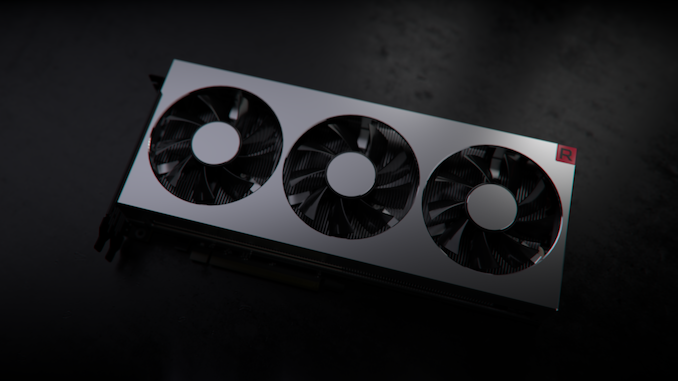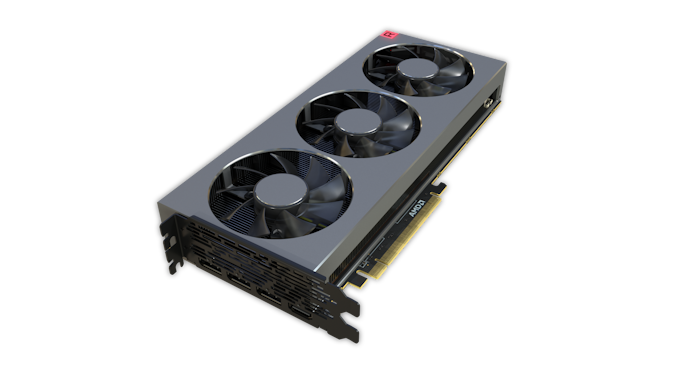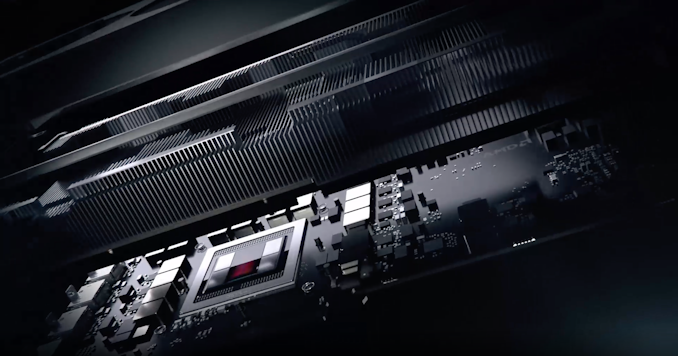The AMD Radeon VII Review: An Unexpected Shot At The High-End
by Nate Oh on February 7, 2019 9:00 AM ESTMeet The Radeon VII
First things first is the design and build, and for the AMD Radeon VII, we've already noticed the biggest change: an open air cooler. Keeping the sleek brushed metal look of the previous RX Vega 64 Limited Edition and Liquid variants, they've forgone the blower for a triple axial fan setup, the standard custom AIB configuration for high-end cards.
While NVIDIA's GeForce RTX series went this way with open-air dual-fan coolers, AMD is no stranger to changing things up themselves. Aside from the RX Vega 64 Liquid, the R9 Fury X's AIO CLC was also quite impressive for a reference design. But as we mentioned with the Founders Edition cards, moving away from blowers for open-air means adopting a cooling configuration that can no longer guarantee complete self-cooling. That is, cooling effectiveness won't be independent of chassis airflow, or lack thereof. This is usually an issue for large OEMs that configure machines assuming blower-style cards, but this is less the case for the highest-end cards, which for pre-builts tend to come from boutique system integrators.
The move to open-air does benefit higher TDP, and at 300W TBP the Radeon VII is indeed one for higher power consumption. While 5W more than the RX Vega 64, there's presumably more localized heat with two more HBM2 stacks, plus the fact that the same amount of power is being consumed but on a smaller die area. And at 300W TBP, this would mean that all power-savings from the smaller process were re-invested into performance. If higher clockspeeds are where the Radeon VII is bringing the majority of its speedup over RX Vega 64, then there would be little alternative to abandoning the blower.
Returning to the Radeon VII build, then, the card naturally has dual 8-pin PCIe connectors, but lacks the BIOS switch of the RX Vega cards that toggled a lower-power BIOS. And with the customary LEDs, the 'Radeon' on the side lights up, as does the 'R' cube in the corner.
In terms of display outputs, there are no surprises here with 3x DisplayPort and 1x HDMI.
A few teardowns of the card elsewhere revealed a vapor chamber configuration with a thermal pad for the TIM, rather than the usual paste. While lower-performing in terms of heat transfer, we know that the RX Vega cards ended up having molded and unmolded package variants, requiring specific instructions to manufacturers on the matter. So this might be a way to head off potential ASIC height difference issues.














289 Comments
View All Comments
just4U - Friday, February 8, 2019 - link
Your just looking for reasons to not like it.. It's a awesome card according to reviews. Is it a 2080ti killer? No. (..shrug) Maybe it might force some pricing down though so you can get one of those.. maybe. For me the 2080ti is 2x the price of the 1080s I own... and I'll not pay that for a video card unless I am in a business setting that requires it.Oxford Guy - Friday, February 8, 2019 - link
"It's a awesome card according to reviews."I read this review. Its noise-to-performance ratio is pathetic in comparison with the 2080 and the Fury X. Full stop.
If you're going to argue at least do something beyond trotting out the lamest dodge technique there is: the ad hominem fallacy.
eva02langley - Friday, February 8, 2019 - link
It doesn't "sux". It is just not disruptive enough for Nvidia fans to expect a price cut on RTX, which is pissing off mroe Nvidia fans than AMD ones it seems.The performances in games are okay, and the compute is really strong. If it is cheaper, it is a better buy. At the same price, I will go Nvidia.
However in Canada, the 2080 RTX is 50-100$ more expensive for blower style cards... with similar accoustics and worst temps.
Oxford Guy - Friday, February 8, 2019 - link
"If it is cheaper, it is a better buy. At the same price, I will go Nvidia. However in Canada, the 2080 RTX is 50-100$ more expensive for blower style cards... with similar accoustics and worst temps."Tu quoque = some blower models are loud, too.
$50-$100 is a very low price tag for one's hearing, comfort, and ability to enjoy audio whilst gaming and/or using the card for other intensive purposes.
Holliday75 - Friday, February 8, 2019 - link
I couldn't give two shits about noise. I wear headphones. I've never paid any attention to it on any product I buy.Oxford Guy - Friday, February 8, 2019 - link
1) Headphones don't negate all noise. Not even the combination of earplugs and headphones designed to absorb noise (and not produce audio) will get rid of noise. It still comes through. One can blast the audio at a higher volume and damage one's hearing to try to cover up noise but that is why the iPod/iPhone younger generations are facing epidemic levels of hearing damage.2) Headphones, as a requirement, are a limitation of the product's functionality.
Firstly, they become uncomfortable. Secondly, they tend to aggravate tinnitus for people with it. Thirdly, they are an extra expense. Fourthly, some have good speaker systems they want to make us of. Etc.
Why advocate limiting one's possibilities for basically the same price, when compared with other, more flexible, products? It's silly. You're gaining nothing and losing potential usefulness.
The only way the headphones point works much in your favor is if the same thing is required of Nvidia's GPU. Otherwise, it's merely you stating that you are a subset of the use cases for this GPU that isn't affected by the noise problem. A subset is not the entirety by any means.
Deaf folks don't have to worry about noise, too. Does that mean they should attempt to dismiss noise problems for everyone else?
LarsBars - Thursday, February 7, 2019 - link
I wish you guys would add Vega 64 liquid to the spec chart comparison: 1700MHz, 13.7 TFLOPs...Ryan Smith - Thursday, February 7, 2019 - link
Unfortunately that's not a card we have. AMD didn't widely sample that one.PeachNCream - Thursday, February 7, 2019 - link
Only $699? This is a midrange GPU in much the same way the $750 monitor was a midrange screen. By recent Anandtech standards, the price does not warrant any mention of high-end. Come on people, we need some consistency on the use of these terms!All teasing about the writing aside, it is nice to see a bit of competition. The Radeon VII is way out of my interest range as a product (it has 8x more VRAM than my daily use laptop has system RAM) but I hope it causes a Red and Green slapfest and brings prices down across all graphics cards. Maybe I'm being too optimistic though.
Korguz - Thursday, February 7, 2019 - link
peachncream... maybe not in your books.. but this is not a midrange card... maybe high end midrange :-)um seems all you have are notebooks... your not in the market for a discrete card ;-)
your laptop only has 2 gigs of ram ?? wow....